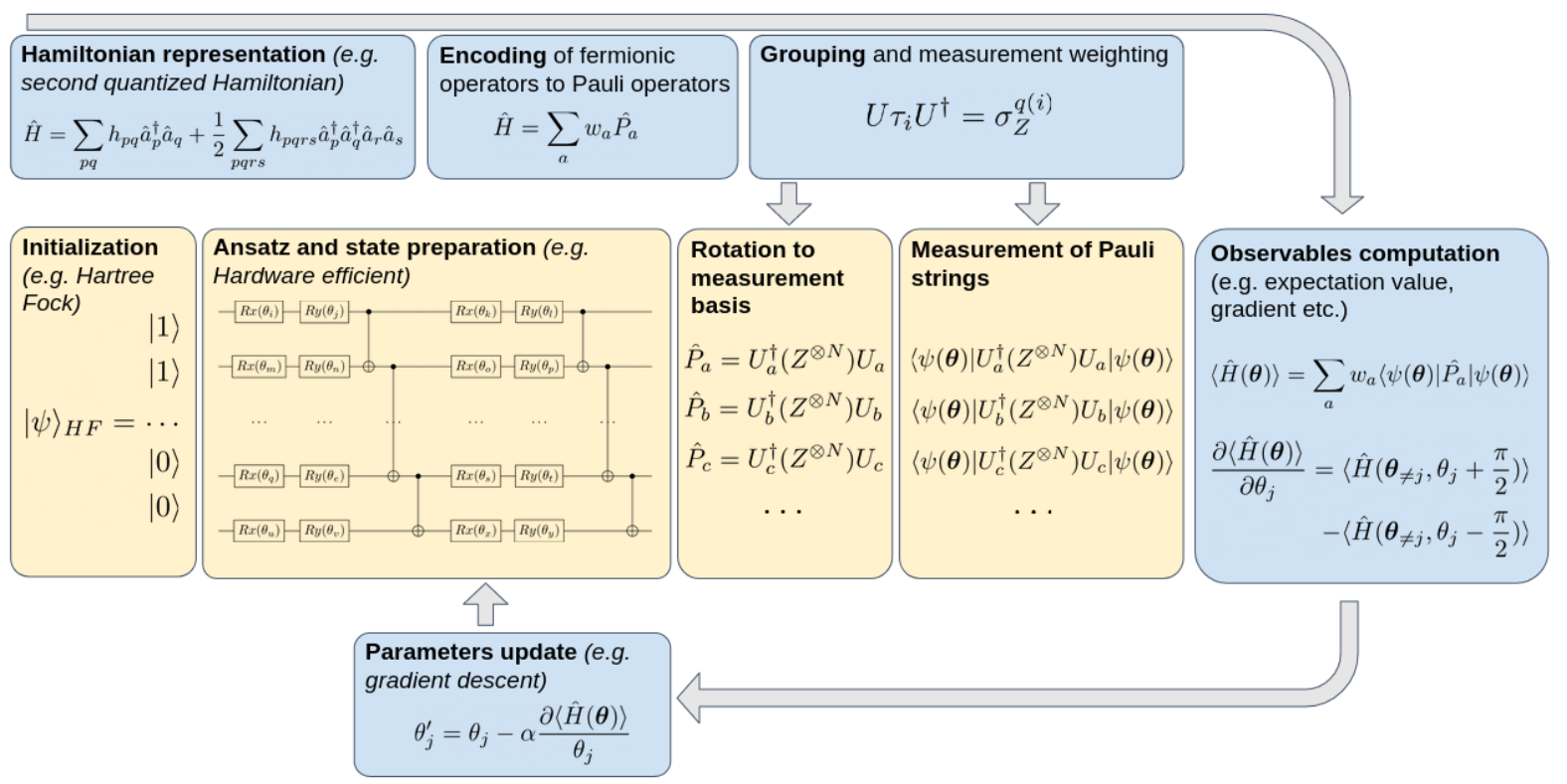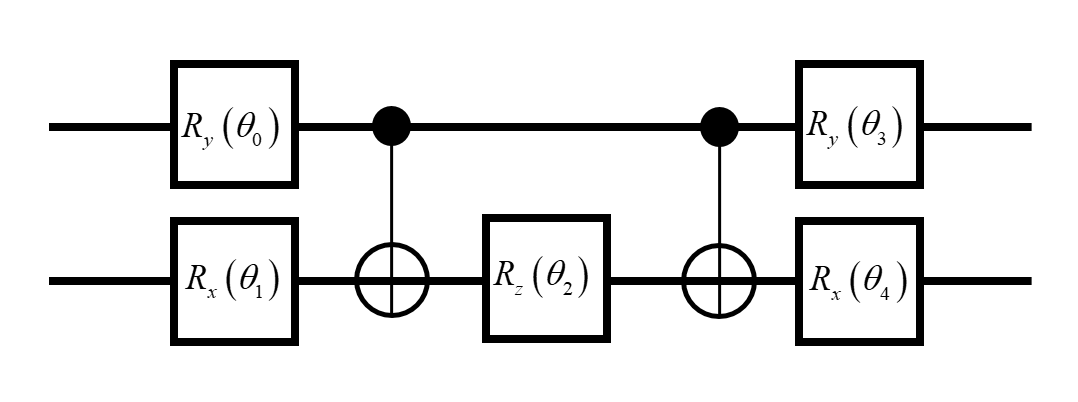Variational quantum eigensolver (VQE)
The eigenvalues of the Hamiltonian determine almost all properties in a molecule or material of interest. The ground state for molecule Hamiltonian is of particular interest since the energy gap between the ground state and the first excited state of electrons at room temperature is usually larger. Most molecules are in the ground state.
Here, molecular electronic Hamiltonian is represented as . A trial wave function is parameterized with , which is called Ansatz. VQE is represented as follows:
is the lowest energy of molecular electronic Hamiltonian . To estimate the , the left-hand side of the equation above is minimized by updating the parameters of the Ansatz .
The molecular electronic Hamiltonian has the second quantized form:
It can be mapped to the linear combination of Pauli operator by Jordan-Wigner transformation or Bravyi-Kitaev transformation as follows:
Then, we can calculate the expectation of Hamitonian with respect to Ansatz by designing quantum circuit. Finally, updating the parameters in the Ansatz quantum circuit to get the the lowest energy of molecular electronic Hamiltonian.
The overview of VQE schematic diagram is as follows:

VQE belongs to hybrid quantum-classical algorithms, in which quantum computer is responsible for executing quantum circuit and classical computer is responsible for updating the parameters of quantum gates in the Ansatz . The lowest energy of molecular electronic Hamiltonian can be obtained and the wave function corresponding to .
To show the algorithm flow, we take the solution for molecule hydrogen's lowest energy as an example in the following code. After Jordan-Wigner transformation in a minimal basis molecule hydrogen Hamiltonian is
We used two qubit in this example,the Ansatz is:

isQ implements VQE through python. we can first write the Ansatz through isQ as:
import std;
procedure main(int i_par[], double d_par[]){
qbit q[2];
X(q[1]);
Ry(1.57, q[0]);
Rx(4.71, q[1]);
CNOT(q[0],q[1]);
Rz(d_par[0], q[1]);
CNOT(q[0],q[1]);
Ry(4.71, q[0]);
Rx(1.57, q[1]);
if(i_par[0] == 0){
M(q[0]);
}
if(i_par[0]==1){
M(q[1]);
}
if(i_par[0]==2){
M(q[0]);
M(q[1]);
}
if(i_par[0]==3){
Rx(1.57, q[0]);
Rx(1.57, q[1]);
M(q[0]);
M(q[1]);
}
if(i_par[0]==4){
H(q[0]);
H(q[1]);
M(q[0]);
M(q[1]);
}
}
Then, updating parameters through python. In python, the compilation and simulation of isQ can be called through os.popen
# ground state energy of hydrogen molecule
from numpy.random import rand
from scipy.optimize import minimize
import os
import json
# compile "h2.isq" and generate the qir file "h2.so"
h2_isq = 'h2.isq'
compile_cmd = f"isqc compile {h2_isq}"
res = os.popen(compile_cmd).read()
if res:
print('compile error')
print(res)
else:
print('compile ok!')
h2_sim_file = 'h2.so'
def get_expectation(theta) -> float:
'''
theta: Angle during preparation
e_n: E_N
get the expectation value of
the Hamiltonian for specific theta
'''
theta = float(theta) # float
hs = [-0.4804, +0.3435, -0.4347, +0.5716, +0.0910, +0.0910]
# coefficients of the Hamiltonian
# for more information, see `PHYS. REV. X 6, 031007 (2016)`
expectations = list() # to store results in a List
expectations.append(hs[0])
E_N = 5
# The first does not require quantum measurement, which is constant
# As a result, the other 5 coefficients need to be measured
# i.e. hs[1], hs[2], hs[3], hs[4], hs[5]
for e_n in range(E_N):
# simulate and get the result
simulate_cmd = f'isqc simulate -i {e_n} -d {theta} --shots 100 {h2_sim_file}'
res = os.popen(simulate_cmd).read()
try:
test_res = json.loads(res)
expectation = 0 # initialize to 0
for measure_res in test_res: # test_res is Dict
frequency = test_res[measure_res]/100 # to get every frequency
# frequency instead of probability
parity = (-1)**(measure_res.count('1') % 2) # to get every parity
# parity checking to get expectation value
expectation += parity * frequency # to accumulate every expectation result
expectations.append(hs[e_n+1] * expectation) # The result is multiplied by coefficients
except:
print('simulate error') # error
print(res)
exit()
return sum(expectations) # to get the final result of Hamiltonian with `hs`
# nelder-mead optimization of a convex function
# define range for theta
theta_min, theta_max = -3.14, 3.14
# define the starting point as a random sample from the domain
pt = theta_min + rand(1) * (theta_max - theta_min)
# perform the search
result = minimize(get_expectation, pt, method='nelder-mead')
# summarize the result
print(f"Status : {result['message']}")
print(f"Total Evaluations: {result['nfev']}")
# evaluate solution
solution = result['x']
evaluation = get_expectation(solution)
print(f"Solution: H_2({solution}) = {evaluation} Eh")
References
- J. Tilly, H. Chen, S. Cao, et al. "The variational quantum eigensolver: a review of methods and best practices." Physics Reports, 2022, 986: 1-128.